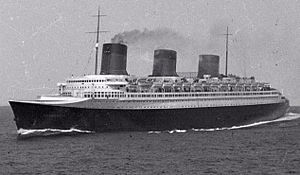SS Normandie

SS Normandie at sea in the 1930s
|
|
| History | |
|---|---|
|
|
|
| Name: | SS Normandie |
| Owner: | Compagnie Générale Transatlantique |
| Port of registry: | Le Havre |
| Builder: | Chantiers de Penhoët, Saint-Nazaire, France |
| Laid down: | 26 January 1931 |
| Launched: | 29 October 1932 |
| Christened: | 29 October 1932 |
| Maiden voyage: | 29 May 1935 |
| Identification: |
|
| Fate: | Caught fire, capsized 1942. Scrapped October 1946 |
| General characteristics | |
| Tonnage: | 79,280 GRT;83,423 GRT |
| Displacement: | 68,500 tons (est.) |
| Length: | |
| Beam: |
|
| Height: | 184 ft (56.1 m) |
| Draught: | 37 ft (11.3 m) |
| Depth: | 57.6 ft (17.6 m) |
| Decks: | 12 |
| Installed power: | Four turbo-electric, total 160,000 hp (200,000 hp max). |
| Propulsion: | Four 3 bladed on launch - later 4 bladed |
| Speed: | Designed speed 29 knots (54 km/h; 33 mph), max speed recorded 32.2 knots (59.6 km/h; 37.1 mph) |
| Capacity: | 1,972: 848 First Class (cabin), 670 Tourist Class, 454 Third Class |
| Crew: | 1,345 |
SS Normandie was an ocean liner built in Saint-Nazaire, France, for the French Line Compagnie Générale Transatlantique (CGT). She entered service in 1935 as the largest and fastest passenger ship afloat; she is still the most powerful steam turbo-electric-propelled passenger ship ever built.
Her novel design and lavish interiors led many to consider her the greatest of ocean liners. Despite this, she was not a commercial success and relied partly on government subsidy to operate. During service as the flagship of the CGT, she made 139 westbound transatlantic crossings from her home port of Le Havre to New York. Normandie held the Blue Riband for the fastest transatlantic crossing at several points during her service career, during which RMS Queen Mary was her main rival.
During World War II, Normandie was seized by US authorities at New York and renamed USS Lafayette. In 1942, the liner caught fire while being converted to a troopship, capsized onto her port side and came to rest on the mud of the Hudson River at Pier 88, the site of the current New York Passenger Ship Terminal. Although salvaged at great expense, restoration was deemed too costly and she was scrapped in October 1946.
The beginnings of Normandie can be traced to the Roaring Twenties when shipping companies began looking to replace veterans such as RMS Mauretania (1906) and RMS Olympic (1911) . Those earlier ships had been designed around the huge numbers of steerage-class immigrants from Europe to the United States. When the U.S. closed the door on most immigration in the early 1920s, steamship companies ordered vessels built to serve upper-class tourists instead, particularly Americans who traveled to Europe for alcohol-fueled fun during Prohibition. Companies like Cunard and the White Star Line planned to build their own superliners to rival newer ships on the scene; such vessels included the record-breaking Bremen and Europa, both German. The French Line began to plan its own superliner.
...
Wikipedia
